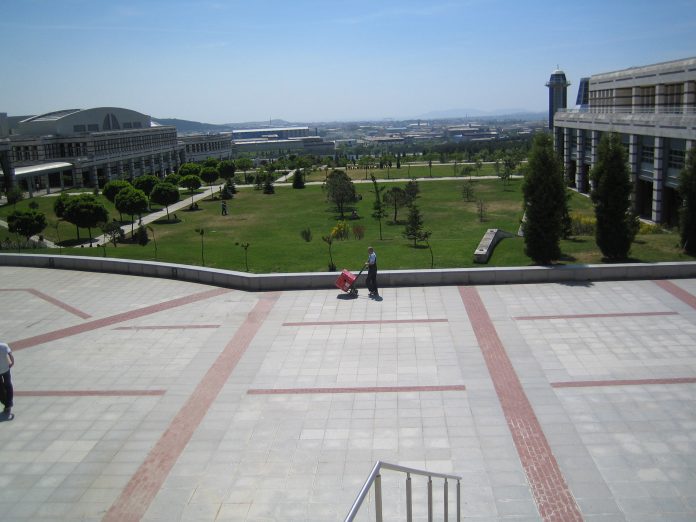While scanning old NYT articles on Turkey, I came across an old article about Turkey’s then-novel private sector universities (1). Sabancı University, the university I’ve been associated with as both student and educator since 2005, plays a prominent role in the reporting.
The article features various details that can be discussed or criticized, but one item caught my attention more than the others. Towards the end of the article, the author makes the following comment: Ambitions are high at Sabanci University, whose campus sits on a dreary hillside about 45 minutes from the city center.
Today, visitors to Sabancı University would wonder at that description, but not only because of the incongruity of the word “dreary” when applied to a campus that now explodes into color in the spring with wisteria, plum trees, and magnolias spread over a mostly green mall that runs through the buildings of a post-modern Ottomanesque design.
Taken together, “dreary hillside” also suggests that the campus was fairly isolated in 2001 when the author (Douglas Frantz) published the article. Now, however, the campus is surrounded by factories and highways teeming with commercial vehicles. In fact, for many foreigners, not only the university’s distance from downtown Istanbul but also its surroundings are a minus. Many at the university are given to perpetually complaining (in rather exaggerated fashion) about this or that industrial stench that invades the campus when the wind is blowing in the wrong direction. In sum, between 2001 and now, the area around the university has sprouted factory after factory, and congestion on the roads leading to the campus has made the commute longer and longer every year.
What’s the point? A long-running debate among Turkey’s political classes about whether Turkey is “really” industrializing or not, and whether exports are “really” playing a leading role in that industrialization, has extended throughout the AKP era. Simply looking at Turkey’s economic production or export figures over the past fifteen years is enough to show how utterly unserious this debate is. Turkey is indeed industrializing rapidly; her economy has grown quickly, massively and sustainably in that time-frame. .
However, much of Turkey’s Kemalist elites, i.e. those who still vote for the CHP, remain adamant that the governing AKP is cooking the economic numbers, that the economy is not growing, that exports are not growing, that somewhere somehow it’s all a big sham. They pooh-pooh the statistics from the state, claiming that the numbers are fake and intended to fool the ignorant masses into voting for the governing party.
Having encountered this silly narrative many times over the years, I long ago devised a simple description to explain to my interlocutors why they are mistaken. You see, the first time I went to Sabancı University in 2004, it was still on that “dreary hillside” that the NYT article describes. The region around the university was largely open pastureland with sheep and goat herds dotting the hillocks.
But in the decade-plus that I’ve been travelling back-and-forth between the university and the city, I’ve been able to observe, on a day-by-day basis, the proliferation of factories, shops, roads, warehouses, traffic, and commerce. My own daily commute clearly and unmistakably reflects Turkish economic expansion and export growth. Otherwise, how could all these factories be built and continue manufacturing products? If trade was not increasing, what could be behind the constantly intensifying flow of trucks and other commercial vehicles?
Today, the freeway that Sabancı University sits next to, commonly known as the TEM (2), is packed with vehicles night and day. The main asphalt artery connecting Ankara with Istanbul, with three lanes in both directions, sometimes at a standstill and sometimes rushing at breakneck, terrifying speed, the TEM’s traffic is notorious for all Istanbul residents. That traffic stems from the massive growth in Turkey’s economy.
What about the negative side-effects? As I mentioned above, pollution is a problem even in the vicinity of Sabancı University. But because the debates about Turkey’s economy have focused on other issues, such as all those useless, self-defeating conspiracy theories about whether the AKP was faking Turkey’s economic data, environmental issues have largely got lost in the process. The CHP, for example, could have done much better by focusing on the environmental costs of Turkey’s industrialization; instead they have wasted their energy and time on useless, frivolous claims. The CHP still has no concrete policy stance on environmental issues (other than the flavor-of-the-month) because they have no organizational capacity to study and then produce real policy suggestions on these or other problems that could attract voter interest.
So today, when you take a trip out to Sabancı University, you will not find the “dreary hillside” described by the NYT fifteen years ago. Instead, you are likely to encounter a hard-working campus community set amongst an ever-growing number of factories. But remember that not so long ago, sheep and goats frolicked where these factories now are.
NOTES
(1) http://www.nytimes.com/2001/03/13/world/private-money-enlivens-university-education-in-turkey.html
(2) The acronym comes from “Trans-European Motorway” as the freeway is a part of that international system.


